| CPC A61B 3/16 (2013.01) [G02C 7/04 (2013.01); A61B 2562/0261 (2013.01)] | 26 Claims |

|
1. A microfluidic strain sensing device for monitoring an intraocular pressure change of an eye, the microfluidic strain sensing device comprising:
(a) a contact lens; and
(b) a microfluidic network embedded with the contact lens,
wherein the microfluidic network has a volume sensitive to an applied strain and wherein the microfluidic network further comprises:
(i) a first fluid reservoir containing a first fluid,
(ii) a second fluid reservoir containing a second fluid that changes volume when the strain is applied, and
(iii) a sensing channel able to hold the second fluid within the sensing channel,
wherein the sensing channel connects to the first fluid reservoir on one end and connects to the second fluid reservoir on another end,
wherein the sensing channel establishes a first fluid-second fluid equilibrium pressure interface and equilibrium within the sensing channel, which fluidically change as a response to radius of curvature variations on a cornea, or as a response to mechanical stretching and release of the cornea, and
wherein the first fluid-second fluid equilibrium pressure interface and equilibrium are used for measuring the intraocular pressure.
|